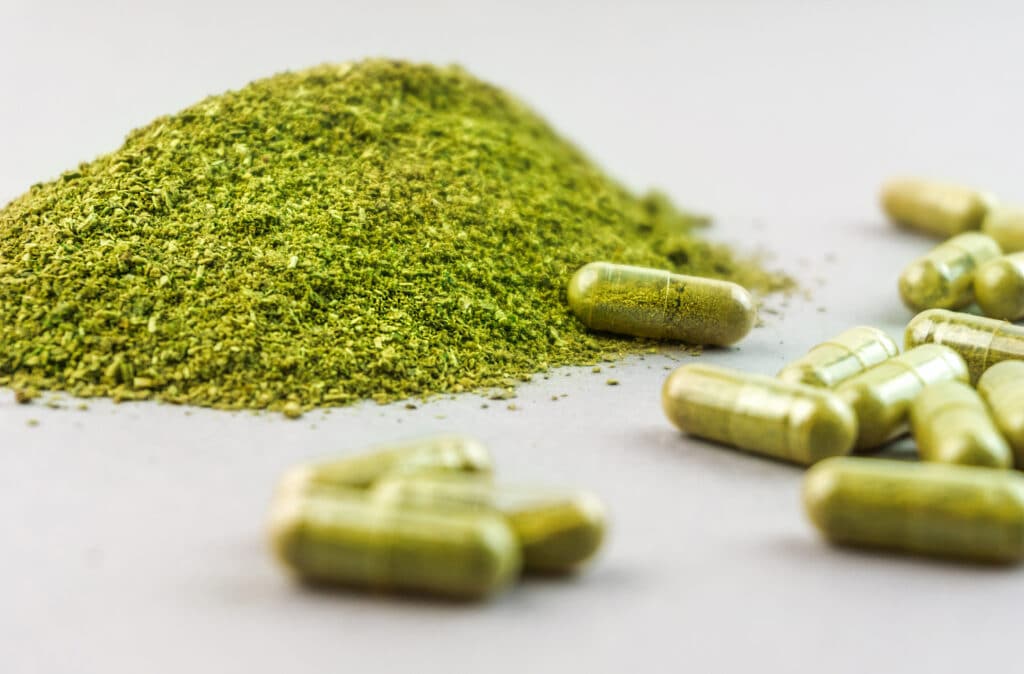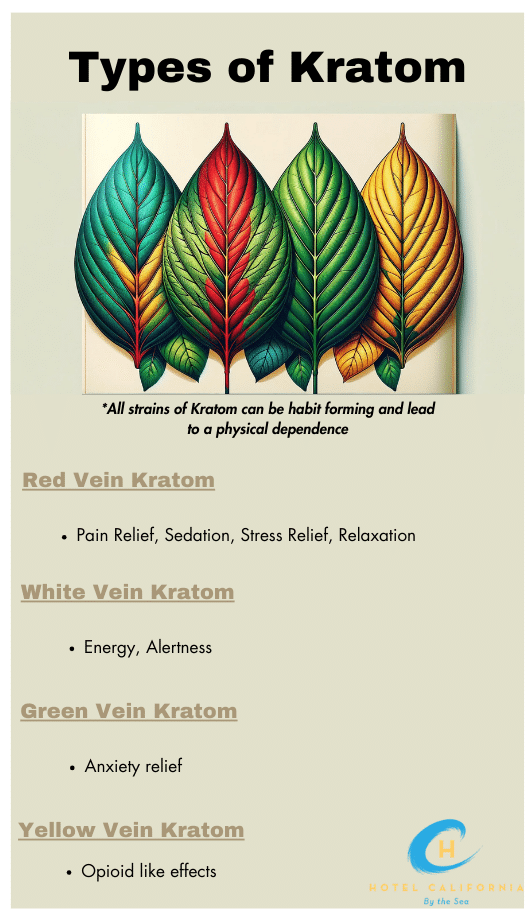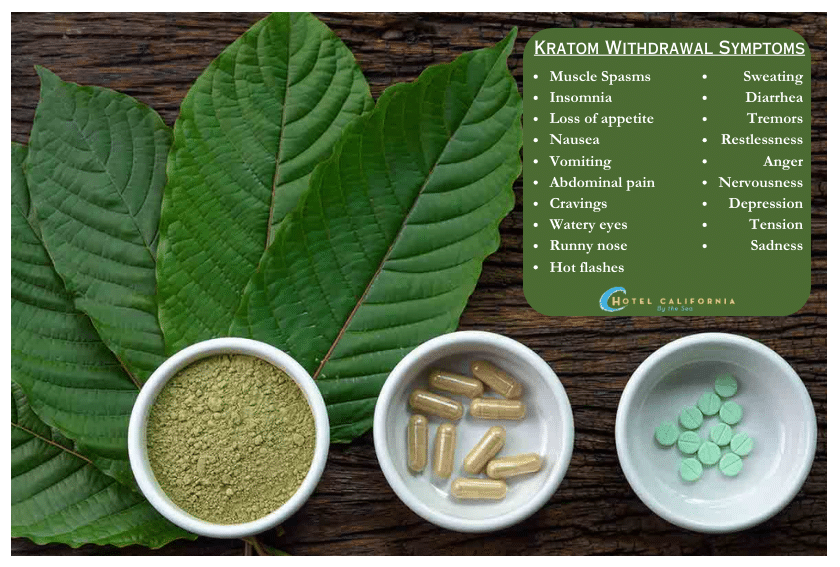How long does Kratom stay in your system?
Kratom is a growing trend in substance use. A study from the consumer advocacy group American Kratom Association found that an estimated 10-16 million Americans regularly use kratom. Also known as mitragyna speciosa, the substance has origins in Southeast Asia. It has been traditionally used as a painkiller to treat chronic pain and fever. It has also been used as an energy stimulator. Today, it is considered a non-traditional alternative to medication and is usually ingested in pill form or as an herbal tea.

How does the herb work? The compound mitragynine breaks down into 7-hydroxy mitragynine in the body when it’s digested. This activates the mu-opioid receptors in the brain. Despite binding with the brain’s opioid receptors, the effects from kratom are not as intense or strong compared to full-body opioids such as heroin or oxycodone.
What is Kratom?
Kratom contains psychoactive and psychotropic properties that can produce both stimulant effects as well as depressive opioid effects. In smaller doses, kratom can produce stimulant effects resulting in high energy. In larger doses, kratom can produce sedative-like effects similar to the symptoms opioid users experience. It can produce intense feelings of calm and pleasure. When the dosage is increased, it can lead to tolerance and abuse. Common side effects of kratom include hallucinations and delusions, increased heart rate, drowsiness, changes in appetite, dry mouth, itching and sweating.
According to the National Institute on Drug Abuse, kratom use is often a form of self-medication to alleviate symptoms of pain, anxiety and depression. In some cases, kratom has been used as part of opioid withdrawal treatments. Though not an opioid drug, kratom use can lead to drug craving effects and habits. In a study, the CDC reported that the autopsies of 152 people who died of overdose between 2016 and 2017, tested positive for kratom.
Kratom is not FDA-approved for any sort of medicinal use. In fact, the FDA has put out a warning about kratom usage due to its minimal research and understanding of long-term effects as well as the potential for dependence and abuse. The substance is legal on a federal level. However, about 30 states have individually passed laws outright banning the sale of the substance. Because of the mixed legal status, kratom products are unregulated making it difficult to predict its effects on the users. Some products may even contain unknown contaminants that could be dangerous.

How long does Kratom stay in your system?
The length of time in which kratom remains active in your system is dependent on many varying factors. How you consume the drug can impact the potency or how quickly the effects can set in. Ingesting a powder encapsulated in a pill can produce a different symptom-effect timeline compared to drinking the substance in an herbal tea. The presence of drugs or mind-altering substances impacts how long kratom can stay active in the body. Individual metabolic rate impacts how quickly or slowly a person’s body can break down and process the drug.
Age also plays an important factor in how long kratom stays in your system. Older people generally have a slower metabolism and therefore process the drug much slower leaving it in the body for a longer period of time. Liver health impacts how well the body is able to process the drug. Most substances are metabolized in the liver and if normal liver functions are impaired, the user will have a more difficult time processing excess amounts of drugs leaving it in the body longer and building up toxicity.
Kratom’s half-life in general is not very long. Research shows the average half-life is about 2 hours. However, the alkaloid mitragynine can be detected up to 24 hours after usage. The effects of kratom can take effect as soon as 5-10 minutes, with a peak at about one hour, and can last for a few hours after. Kratom can remain in a person’s system for much longer after the effects have worn off. It takes about 5-6 half-lives for the kratom to be eliminated from the body. This means kratom can remain in the body for about a week after the initial dosage.

Kratom Withdrawal Timeline
Because kratom interacts with the same receptors in the Central Nervous System, over time, the drug can alter brain chemistry. When brain chemistry is altered, it can lead to tolerance, dependence and addiction. When a psychological or physical dependence has developed, users may experience withdrawal symptoms when kratom use has stopped or significantly decreased.
How quickly or intensely withdrawal symptoms take into effect can depend on how much kratom has been consumed and how long the user has been consuming it. Symptoms of withdrawal generally appear within 12-24 hours and can last anywhere from 3-10 days.
- Day 1-2 – Symptoms can begin within 24 hours of the last dose and include anxiety, depression, sweating and other flu-like symptoms.
- Day 3-4 – During this time, withdrawal symptoms will begin to peak in intensity within the first four days of initial use. Users can experience severe cravings, stomach issues and sleep issues.
- Day 5-10 – Symptoms will begin to fade, but users can continue to struggle with psychological withdrawal symptoms such as drug cravings and feelings of depression.
Check Your Insurance Coverage for FREE
Find out if your insurance covers addiction treatment in minutes. We accept most insurance!
Other withdrawal symptoms include:
- Abdominal pain
- Agitation and irritability
- Changes in mood
- Anxiety and depression
- Intense drug cravings
- Appetite loss
- Muscle aches
- Diarrhea and vomiting
- Restlessness
- Runny nose, sweating, and watery eyes
- Insomnia and other sleep disturbances
It is generally advised not to quit kratom cold turkey. Because of its impact on the central nervous system, quitting abruptly could lead to dangerous withdrawal symptoms and effects. A tapering system of detox is recommended when treating a dependence or addiction to kratom.
Other ways to help ease withdrawal symptoms include:
- Over-the-counter pain medications to help with muscle aches and fever
- Staying hydrated helps with symptoms of vomiting and diarrhea
- Eating small and frequent meals can help with nausea
- Getting rest and sleep will help with feelings of irritability and anxiety
- Practicing relaxation techniques such as breathing exercises, meditation and yoga
- Talk to a mental health professional and seek assistance at a professional behavioral health treatment program
Reach out to Hotel California by the Sea
We specialize in treating addiction and other co-occurring disorders, such as PTSD. Our Admissions specialists are available to walk you through the best options for treating your addiction.
Treatment of Kratom Abuse
Kratom is a psychoactive substance that can produce feelings of relaxation and euphoria. Because kratom affects the central nervous system, users are at risk of developing a tolerance and dependence on the herb. At Hotel California by the Sea, we provide unique treatment programs targeting psychoactive drug addiction that include substances such as kratom. We offer substance detox, residential programs, PHP and IOP programs for clients at all levels of addiction recovery.
Through our evidence-based treatments such as CBT, EMDR therapy and family therapy, clients will be able to address their addiction on an emotional and psychological level. Often substance addictions coincide with a mental health condition. Hotel California by the Sea specializes in treating co-occurring mental health disorders. By addressing all aspects of the addiction simultaneously, clients can see a better outcome in their healing and recovery journey.
References:
https://www.healthline.com/health/kratom-withdrawal
https://anrclinic.com/kratom-withdrawal-detox/
https://www.ncbi.nlm.nih.gov/pmc/articles/PMC10098727/
https://www.rehabcenter.net/kratom/detection-time/
https://zinniahealth.com/substance-use/kratom/duration
https://npaddictionclinic.com/blog/how-long-does-kratom-stay-in-your-system/
https://www.usatoday.com/story/news/health/2023/05/27/kratom-herbal-drug-side-effects-legal-explained/70253695007/
https://nida.nih.gov/research-topics/kratom#kratom
https://www.forbes.com/health/supplements/kratom/
